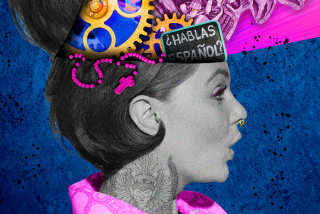Facundo Bernal’s poems spotlight early Chicano life in L.A. long before border walls
As the president issues the first veto of his tenure after Congress rejected his declaration of a national emergency to fund his wall, it’s hard to imagine that the dynamics along the U.S.-Mexico border were once different, when people shuttled back and forth between the two nations. Facundo Bernal marks such a moment in “Palos de Ciego,” his manuscript of poetry translated to English for the first time by Anthony Seidman as “A Stab in the Dark” for the Los Angeles Review of Books.
This iteration of “Palos de Ciego” comes to us when the political climate turns its attention to the border and to migrant caravans. Perhaps it is ironic, then, that this body of writing, only recently rediscovered, surfaces now as a reminder of “a time, before fences, walls, and the Border Patrol, when the border only existed to be crossed,” writes Josh Kun, a 2016 MacArthur Fellow and USC professor, in the book’s introduction.
‘Palos de Ciego’ stands as one of the earliest bodies of literature chronicling the experiences of Chicanos in Los Angeles.
The poems collected in “Palos de Ciego” were first published in the newspaper La Prensa in 1921. Writing under the pseudonym Míster Blind, Bernal’s work offers a unique perspective on the experiences of Latinos during a period when the city was in the midst of an economic boom and Los Angeles’ Mexican American population swelled in numbers. “‘Palos de Ciego’ is one of the first books of poems about the city, and yet it is nowhere to be found in accounts of L.A. literary history,” Kun continues. In fact, one is hard pressed to find any information about the writings of Facundo Bernal — or anything on the man himself, for that matter. A quick online search reveals a few scant details about the life and work of a writer whose poetry provides keen insight into the lives of Mexican Americans during the early 20th century. “Palos de Ciego” stands as one of the earliest bodies of literature chronicling the experiences of Chicanos in Los Angeles, a radical new telling of a subject we thought we already knew, one we thought had already been written.
A true fronterizo, Bernal was born in Hermosillo, Mexico, in 1883 and came of age during the reign of one of the country’s most recognized despots — Porfirio Díaz. Along with his brother Francisco, Bernal’s work and political and artistic views were shaped and influenced by the country’s burgeoning literary community. Bernal first came to Southern California in 1913 as an exiled journalist whose brash and belligerent screeds against the dictatorship of Díaz and the political corruptions of Mexico had resulted in death threats and stints in jail. He found sanctuary in Los Angeles, in “[our] divine city/ of beachside resorts/ and parks brimming/ with lush lakesides,/ in the beautiful Angelo-polis/” he tells us in his poem, “The Crime Wave.”
Crossings, in all their permutations — cultural, political and linguistic — abound in Bernal’s work. Yet these are not done blindly and without rhyme or reason. In a very public forum, we see a writer documenting the emergence of a border subjectivity, documenting an identity formed from two cultures that are inextricably linked by geography, history and language. These poems remind us of the messiness that is bi-culturalism, of the way selves overlap, spilling over and out, again and again, decade after decade. Himself a composite of many selves, Bernal flaunts and revels in the fragmented bricolage of identity that is the hyphenated American at a time when such concepts were still nascent.
Bernal’s linguistic acrobatics stretch and pull words, both English and Spanish, calling attention to their elasticity. This is often demonstrated with the incorporation of hybrid phrases in his poetry such as “gud taim” (“good time”), “What su mara?” (“What’s the matter?”) and “Cheeses Cries!” (“Jesus Christ!”). Here is a prototype of the mixed idiomatic phrases future generations would come to adopt, before caló or Spanglish, languages largely used by zoot suiters and urban Mexican American youths across L.A. and the greater Southwest. And perhaps this is the book’s greatest achievement: that an artist writing during such a pivotal time in the formation of a city like Los Angeles would be so bold as to adopt this renegade identity, flirting with words and language before such things in written texts were common. “Palos de Ciego” lays the foundation for the formation of a literary identity for Mexican American writers in Los Angeles.
But it’s not just language Bernal toys with and chops up. He takes “stabs” at the ruling establishment back home, commenting on the political machinations of Mexico in poems such as “Ah, that Don Félix!” named for the general who, along with several others, including Victoriano Huerta, led a coup to overthrow Francisco I. Madero. “Is poor Don Félix / completely blind to facts?” Bernal writes.
“His delirious plots
have always failed him.
Hasn’t the White House
told him their No no no’s,
because they don’t want
Más Revoluciones?”
Weightier subject matters such as the Mexican Revolution and coup d’états are moderated by more playful pieces that interrogate culture and identity. In “Raking Up the Past,” for example, he “dedicate[s] a few “stabs” / to the people of [his] Raza / who leave Mexico, and when they’ve barely set foot in Yankee-landia, forget their Spanish / and disown their Homeland.” While in the poem “Better Off Being Chinese,” he writes:
“Dear Reader, after a prolonged hiatus of three days,
I return to my bitter task
of talking trash
against those of our ilk
who disown their ancestors in a most inhuman manner,
then set themselves up as model Bad Mexicans.”
In her book “Borderlands/La Frontera,” Gloria E. Anzaldúa writes, “The U.S.-Mexican border es un herida abierta where the Third World grates against the first and bleeds. And before a scab forms it hemorrhages again, the lifeblood of two worlds merging to form a third country — a border culture.” Bernal’s “Palos de Ciego” works to remind us that all borders, real and imagined, exist only to be crossed and recrossed. This cultural divide, this ambiguous space, scarred and tattered by the throngs of immigrants seeking asylum from poverty, political turmoil and violence, is the domain of revolutionaries and outlaws. Of his own work, he wrote: “And so, here are my poor and blind stabs at the dark; let the reader receive them knowing full well what they are: coarsely cut spears, chopped up at random, useless, except perhaps as serving for fuel, as purification from all sin. Amen.”
“‘Palos de Ciego’ is one of the first books of poems about the city, and yet it is nowhere to be found in accounts of L.A. literary history.”
— Josh Kun
Here is a testament to the ambiguity that is born out of collision and conflict, where one identity does not fold into the other, where one cultural marker does not give way for another to take its place, but where the two remain in an equal balance. The result is a sensibility that manages somehow — someway — to cut through the darkness forever threatening to engulf us all.::
‘A Stab in the Dark / Palos de Ciego’
Facundo Bernal, translated by Anthony SeidmanLos Angeles Review of Books, 280 pp., $16
Espinoza’s book, “Cruising: An Intimate History of a Radical Pastime,” will be published in June by Unnamed Press.
More to Read
Sign up for our Book Club newsletter
Get the latest news, events and more from the Los Angeles Times Book Club, and help us get L.A. reading and talking.
You may occasionally receive promotional content from the Los Angeles Times.






